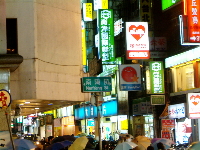
Buxiban Culture
| Implications Behind Cramming |
|
The “craze” for attending buxibans has swept over Taiwan , and in Taipei City , where the competition of getting into prestigious high schools and colleges is most fierce, that is especially epitomized by the Nanyang Street . With an increasing number of students going there for “cramming,” various businesses in the neighborhood have thrived. Add to that, an extremely distinct streetscape took shape. The Nanyang Street is to buxiban culture what one's body to their soul. The bond between them is unbreakable. By carrying out all the interviews and questionnaire surveys, as well as juxtaposing buxiban culture, human-environment relationship, and streetscape, we intend to see if there is indeed some interconnectivity between buxibans and the surrounding streetscape. In " The Influence of Buxiban Culture on the Human-Environment Relationship", the questionnaires show that most students habitually make purchase on their way to buxibans, and that food, beverages, and stationery play a major role in the consumption. Street intercept interviews, on the other hand, showcase the reasons behind people visit the Nanyang Street and how frequent they go there. Through data analysis and cross-reference, we could then reach the conclusion that the influence of buxiban culture on the human-environment relationship consists in the high mobility of people. Businesses within walking distance have become the venues where consumption of goods soars. High demand means more opportunities for suppliers, who would in turn expedite production of commodities, food in particular. Therefore, the role of buxibans is essential in that the after-school class hours every day create not only groups of mobile students but also regular customers. They serve as a linchpin in the human-environment relationship; when these cram schools start determines the size of crowd and the sales of surrounding businesses. In the end, more new buxibans would join the Nanyang-Street bandwagon. |
Relationship as such proves the interconnectivity between buxiban culture and streetscape. In accordance with our field study, the distribution of buxibans and that of various businesses almost overlap with each other. Where cram schools are few, stores are scarce. In " The Influence of Buxiban Culture on the Streetscape", data indicate that food and beverages account for most of the consumption; that result is comparable with the purchasing behavior of students in " The Influence of Buxiban Culture on the Human-Environment Relationship". This surprisingly high reliance on Nanyang buxibans makes us wonder why there are so many “crammers” these days. Finally, to redefine buxiban culture, we may as well say that it makes changes to human-environment relationship and streetscape, create crowds of students lining up in front of elevators, and enters the collective memory of one generation after another. Strange it may be, buxiban culture has become part of the modern society in Taiwan .
|
Copyright © 2007 CKHSC1st. All rights reserved.
